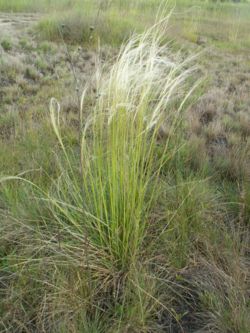| Stipa borysthenica | |
|---|---|
 | |
| Scientific classification | |
| Kingdom: | Plantae |
| Clade: | Tracheophytes |
| Clade: | Angiosperms |
| Clade: | Monocots |
| Clade: | Commelinids |
| Order: | Poales |
| Family: | Poaceae |
| Subfamily: | Pooideae |
| Genus: | Stipa |
| Species: | S. borysthenica |
| Binomial name | |
| Stipa borysthenica | |
Stipa borysthenica is a perennial bunchgrass species in the family Poaceae, native to Europe and Asia.
Contents
It is a common species in a wide area of Kazakhstan and southern parts of Russia. In many European countries (e.g. Czech Republic, Slovakia, Poland, Hungary, Ukraine) it is a post-glacial relict and protected endangered plant.
